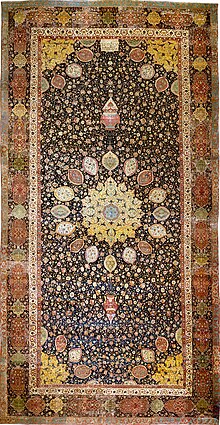

The Ardabil Carpet (or Ardebil Carpet) is the name of two different famous Persian carpets,[1] the larger and better-known now in the Victoria and Albert Museum in London. Originally there were two presumably identical carpets, and the London carpet, as restored and reconstructed in the 19th century, uses sections from both. It now measures 34 ft 3 in × 17 ft 6+7⁄8 in (1,044 cm × 535.5 cm).[2] The other carpet, now in the Los Angeles County Museum of Art, and smaller at 23 ft 7 in × 13 ft 1+1⁄2 in (718.82 cm × 400.05 cm),[3] was made up of the sections in adequate condition unused for the London carpet. Both carpets are now smaller (shorter in particular) than they would have been originally, and there are other fragments in various collections that appear to come from the reconstruction process.[a] The carpets have a typical Tabriz design, with one central medallion and smaller, ornate designs surrounding. Such medallions and shapes were central to the design and reality of Persian gardens, a common symbol of paradise for followers of Islam.[5]
A cartouche on the London carpet contains the date A.H. 946, or 1539-40, which is thought to be the earliest date on any Persian carpet.[4]
- ^ Mokhberi 2019, p. 118; Beattie 1986, pp. 365–368; Spuhler 1986, pp. 708–709.
- ^ "The Ardabil Carpet". Victoria and Albert Museum. Retrieved 14 September 2021.
- ^ "Ardabil Carpet". LACMA Collections. Retrieved 14 September 2021.
- ^ a b Beattie 1986, pp. 365–368.
- ^ Cite error: The named reference
Getty autobiographywas invoked but never defined (see the help page).
Cite error: There are <ref group=lower-alpha> tags or {{efn}} templates on this page, but the references will not show without a {{reflist|group=lower-alpha}} template or {{notelist}} template (see the help page).